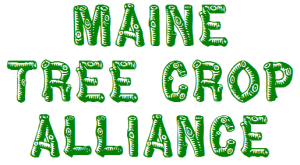About the MTCA
Where do we go from here?
by Jack Kertesz, Winter 2008
 The Maine Tree Crop Alliance was launched by a starry eyed young man 25 years ago with a healthy glimpse into the past and an optimistic eye to the future. There were other true believers in the area and in the country who saw unrealized potential in trees, well beyond their current use. I saw a need to link both human and natural resources and felt prompted by both. Thus the Alliance was born.
The Maine Tree Crop Alliance was launched by a starry eyed young man 25 years ago with a healthy glimpse into the past and an optimistic eye to the future. There were other true believers in the area and in the country who saw unrealized potential in trees, well beyond their current use. I saw a need to link both human and natural resources and felt prompted by both. Thus the Alliance was born.
You can peruse some of the old MTCA newsletters on the web and amid chuckles and raised eyebrows, perhaps glean some useful information. With the help of Tom Roberts, I feel that it actually shaped up into a reputable publication. I dropped the newsletter writing and editing for a number of reasons. I have even let my passion for promotion of these plants slip.
With lead help from John Bunker and other cronies the major event, the annual Spring Scion Wood Exchange has continued and expanded in scope to include seed and continues to draw a crowd of veteran and novice tree growers. On the sidelines, I continue to observe the keen interest of young and old people alike, who arrive to actively partake in the cycle of producing their own food. It a nourishing feeling. Keep up the sharing!
Learning As We Grow
What do we know? What do we really know about plants growing in this environment, bioregion or space we define as Maine. Who could write up the definitive list of plants to grow for food, feed and fiber. Where would these plants do best. What cultural requirements would they have, what plant companions would benefit them, what would their communities look like, and how would they be utilized by man or beast. What varieties would be most appropriate in a given area, who are the people already growing them AND what would all this be worth?
I’ve had these questions and more for some time and at some point undertook to find the answers. In my search I stumbled across a number of people who independently set out to crack some portion of this tough nut. The trail I followed was never paved with money but rather with passion. The guiding spirit of the people I met fueled their quest to uncover another piece of the puzzle. Infusing hope in a seed or scion, they gained some personal satisfaction when, rewarded with the fruit, hand went to mouth.
 I may have fewer answers now. I’ve lost contact with a number of people and many of my own plantings have succumbed to pests and neglect. Just where did that network and all of that nutwork go? How branched out did any of this effort spread? Who’s seen and identified what has potential for promotion and propagation? Who can say from first hand experience what works for them and where it might be of value.
I may have fewer answers now. I’ve lost contact with a number of people and many of my own plantings have succumbed to pests and neglect. Just where did that network and all of that nutwork go? How branched out did any of this effort spread? Who’s seen and identified what has potential for promotion and propagation? Who can say from first hand experience what works for them and where it might be of value.
Amidst a a windfall of information on the Net, I still find it particularly difficult to extract practical and reliable advice. I have always believed that an observant individual, spending time with a particular plant can make a significant contribution to illuminating us all. More importantly perhaps, by avoiding the status of expert, they remain open to possibilities.
Would that be you? I’m willing to go out on a limb and suggest that plants have a lot to teach us and that our listening skills improve as we watch them. Maybe they shape our reality or at least our realization that we all truly live in a garden. Do you have an experience to share? What would you post here? I’m not in a position at this time where I could handle any deluge of requests for info, yet I would still like to help facilitate the flow of ideas that will help us construct a bountiful future. Send your suggestions on how to revamp the network to me: Jack Kertesz
NURSERY AND PLANTING SUGGESTIONS
One of the more useful and extensive lists on the web can be found on the Permaculture Activist web site. If you stick with Northern tier states you can reduce some of the tedium of surfing. Some of the smaller, less glitzy nurseries (and there are some down South) have excellent stock, interesting selections and are worth supporting. There are a few catalogs in the trade with more hype than help, where overuse of adjectives (especially “hardy”) abound. The nursery industry is slowly evolving; more regional, reasonable suppliers are a welcome addition. I’ll toot Fedco Trees horn here, they have managed to flush out some interesting varieties and are persistent in their search for those appropriate for this region. They also encourage local production.
Plants are expensive and need care from the day they are received. I recommend that people hold back on their purchases and take a year to get their site ready. This can be as laid back an effort as placing a mixture of ingredients that will decay on the spot where you plan on planting. You don’t need to buy anything, be a creative scrounger for organic material. Transplanting will be a breeze and your stock will respond favorably to this treatment. Be a local employer. Let an army of microorganisms pre-condition your soil!

